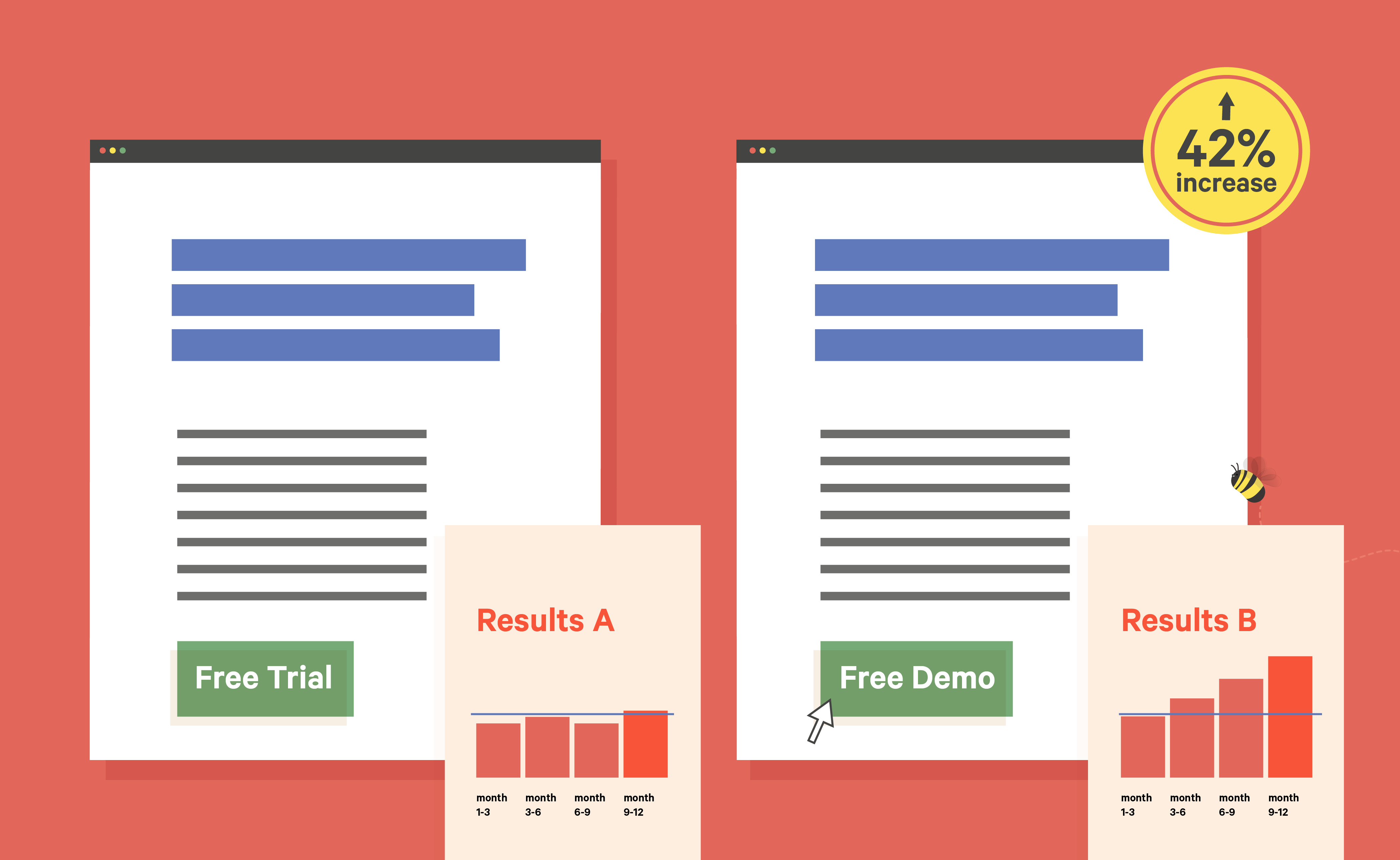How Changing One Word Increased Software Demos By 42%



Sometimes the simplest things can make the biggest impact. Some examples of that we’ve covered in other blog posts:
- How To Grow Website Traffic By 37% With Your Existing Blogs: Rather than writing a number of new posts, we simply updated a few of our old posts. This tactic brought in 27,000 new blog views over a two-month period.
- How To Increase Your Blog Leads By 60%: Rather than creating a bunch of new whitepapers and ebooks, we added a new kind of call-to-action (CTA) on our existing posts. For one client, we saw a 60% increase in conversion rate.
Here’s to doing less to grow more.
Last year, we had an idea to make a simple change on a client’s website that could potentially make a big impact. What would happen if we changed the main website call-to-action from “Free Trial” to “Free Demo?”

It’s a laughably simple idea, but the opportunity was big.
The Scenario
This is where we stood before making a change to the website’s main call-to-action.
- The goal of the sales process had always been to interest people in an online, one-on-one software demonstration. Based on the industry and how the software tool was used, a demonstration and discussion was more useful to the prospect than a free trial.
- The main call-to-action had always been “free trial,” even though a demo would come first and then a free trial next (if the demo went well). It was a roundabout process for sales prospects.
- We gave everyone the ability to schedule a one-on-one demo, even people whose organizations were located outside the countries we worked with or wouldn’t benefit from the software. This was a waste of time for our salesperson.
The Goals
Here’s what we wanted to accomplish by changing our main website call-to-action.
- We wanted the existing pool of website visitors and prospects to produce more demo opportunities. Therefore, we changed the main site CTA from “free trial” to “free demo.”
- We wanted to stop giving demos to people who weren’t qualified. Therefore, we automatically routed people who weren’t qualified (based on the info gathered on the demo form) to a recorded video and other resources.
The Results
*Three-month Stats Before & After The CTA Change

*BOF = Bottom of funnel (the views and submissions on our free trial and demo landing pages)
Takeaways
Views: Views of our BOF landing pages (free trial and demo) increased by 24%.
- That is not something we anticipated, but it turned out a demo was more compelling than a free trial for our persona.
Submissions: People who submitted the form to request a BOF action increased by 37%.
- We lost a number of free trial requests (by deprioritizing that CTA) but increased demo requests by a lot more. The result was a big increase in leads. Again, our persona finds this option more compelling.
Demos scheduled: The number of demo meetings we scheduled with prospects increased by 59%.
- The increase in views and submissions was an added benefit. But “demos scheduled” was really where we targeted by making the change.
- Now, the intent of the prospect (to request a demo) matched with what they actually received.
- Also, we cut out people who weren’t a good fit, freeing up time for our salesperson to focus on the right leads.
Demos completed: The number of people who attended the scheduled demos increased by 42%.
- The difference between “scheduled” and “completed” is people who didn’t show up to the meeting. That’s part of the game.
- By switching our main CTA (and improving the filtering), we increased real demonstrations in a meaningful way.
The call-to-action matched the process, which matched the preference of the website visitor. Something that was so simple made a big impact.
Areas you can look to for minimal effort & big impact
The point of this article is not to test your website’s main call to action. Although that could be a good strategy for you, the idea here is to find opportunities to make small changes that have the chance to make a big impact.
Oftentimes in marketing, people think doing more—or more complex things—will help them to grow. Instead, look for simpler ideas that could have a big impact.
If you’re looking for areas with low-effort, high-impact potential, start here:
- Main website CTAs (just like this test)
- Blog CTAs (changing one CTA on your most viewed blog post could be worth the effort of ten new blog posts)
- Pricing (the actual price, the packages, how people see your prices)
- The pages that rank for your main keyword rankings (fixing a keyword ranking drop from four to seven in Google could be more impactful than getting 100 long-tail keywords onto page one)
- Headers and important website copy (your homepage header may only be four words, but it can make a big difference)
- Landing page format or copy (like headers, landing pages are typically fewer words but capture most of your leads)
- Emails and workflows (take a look at your most-seen emails and test out different content)
There are a million things you could test in your marketing, but you shouldn’t try to pursue them all. Start by looking where you attract the most eyeballs, and do a few simple tests to see if you can improve how it works.

